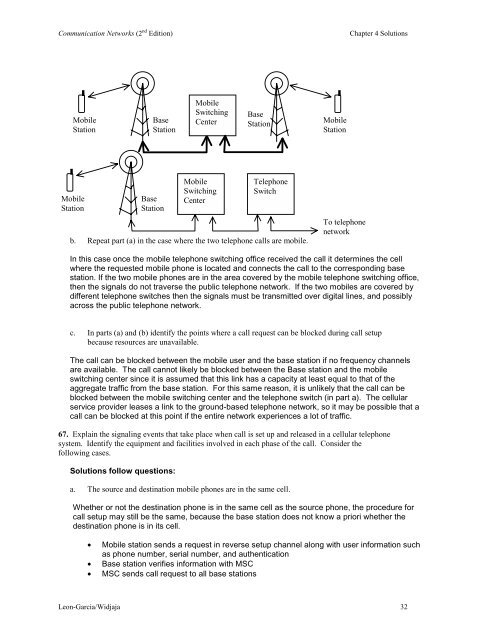Solutions to Chapter 4 - Communication Networks
Solutions to Chapter 4 - Communication Networks
Solutions to Chapter 4 - Communication Networks
Create successful ePaper yourself
Turn your PDF publications into a flip-book with our unique Google optimized e-Paper software.
<strong>Communication</strong> <strong>Networks</strong> (2 nd Edition)<br />
<strong>Chapter</strong> 4 <strong>Solutions</strong><br />
Mobile<br />
Station<br />
Base<br />
Station<br />
Mobile<br />
Switching<br />
Center<br />
Base<br />
Station<br />
Mobile<br />
Station<br />
Mobile<br />
Station<br />
Base<br />
Station<br />
Mobile<br />
Switching<br />
Center<br />
Telephone<br />
Switch<br />
b. Repeat part (a) in the case where the two telephone calls are mobile.<br />
To telephone<br />
network<br />
In this case once the mobile telephone switching office received the call it determines the cell<br />
where the requested mobile phone is located and connects the call <strong>to</strong> the corresponding base<br />
station. If the two mobile phones are in the area covered by the mobile telephone switching office,<br />
then the signals do not traverse the public telephone network. If the two mobiles are covered by<br />
different telephone switches then the signals must be transmitted over digital lines, and possibly<br />
across the public telephone network.<br />
c. In parts (a) and (b) identify the points where a call request can be blocked during call setup<br />
because resources are unavailable.<br />
The call can be blocked between the mobile user and the base station if no frequency channels<br />
are available. The call cannot likely be blocked between the Base station and the mobile<br />
switching center since it is assumed that this link has a capacity at least equal <strong>to</strong> that of the<br />
aggregate traffic from the base station. For this same reason, it is unlikely that the call can be<br />
blocked between the mobile switching center and the telephone switch (in part a). The cellular<br />
service provider leases a link <strong>to</strong> the ground-based telephone network, so it may be possible that a<br />
call can be blocked at this point if the entire network experiences a lot of traffic.<br />
67. Explain the signaling events that take place when call is set up and released in a cellular telephone<br />
system. Identify the equipment and facilities involved in each phase of the call. Consider the<br />
following cases.<br />
<strong>Solutions</strong> follow questions:<br />
a. The source and destination mobile phones are in the same cell.<br />
Whether or not the destination phone is in the same cell as the source phone, the procedure for<br />
call setup may still be the same, because the base station does not know a priori whether the<br />
destination phone is in its cell.<br />
• Mobile station sends a request in reverse setup channel along with user information such<br />
as phone number, serial number, and authentication<br />
• Base station verifies information with MSC<br />
• MSC sends call request <strong>to</strong> all base stations<br />
Leon-Garcia/Widjaja 32







